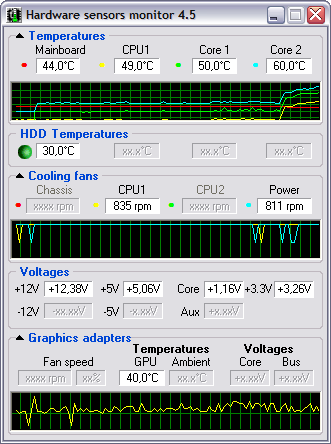
To do so, click the Properties button on the toolbar. As such, you’ll want to change the sampling interval, which will in turn extend the Duration. That’s because, by default, the sampling interval is set at 1 second and the graph is set to use a default time period, called the Duration, of 1 minute 40 seconds. As you’ll notice, the timer bar will be running very quickly. At this point, you’re ready to configure the monitoring operation.Īs soon as you return to the Memory Tracker, you’ll see that it’s already charting your memory usage in the graph area. To continue, click the Close button to dismiss the Add Counters dialog box. By memory potential, I’m talking about both physical and virtual memory.
HARDWARE MONITOR FOR XP WINDOWS
For now, just keep in mind that the reason I selected counters from these particular Performance Object categories is that when combined, they provide an excellent picture of how Windows XP is utilizing its memory potential during a typical computing session.
HARDWARE MONITOR FOR XP HOW TO
I’ll discuss these counters in more detail later when I explain how to interpret the results of the monitoring operation. As you do so, you’ll see that counter appear in the graph and in the legend below the graph. As you select each counter, click the Add button. Select an object from the Performance Object drop-down list and then select the associated counters from the scrolling counters list. PhysicalDisk - Current Disk Queue Length * When you see the Add Counters dialog box, you’ll use this data to add the necessary counters to the graph: To begin, maximize the window, select the Memory Counters icon, and then click the Add button on the Performance Monitor toolbar that appears in the right panel.

Once you’ve created your custom Memory Tracker console, you’re ready to add the counters that will allow you to track memory usage. Then, on the Insert ActiveX Control page, type Memory Counters in the text box and click Finish. Scroll through the Control Type list, select System Monitor Control and click Next. When the Control Category and Type page appears, leave the All Categories option selected in the Control Category drop-down list. When you see the Welcome page, just click Next. When you see the Add/Remove Snap-in dialog box, click the Add button to open the Add Standalone Snap-in dialog boxīy default the ActiveX Control snap-in will be selected, and you can immediately click the Add button to launch the Insert ActiveX Control Wizard. Now, pull down the File menu and select the Add/Remove Snap-in command. Then, right-click on the Console Root folder, select Rename, and name the folder Memory Tracker.

When you see the empty console, pull down the File menu, select the Save command, name the console Memory Tracker.msc, and then click the Save button. To begin, access the Run dialog box from the Start menu and type mmc in the Open text box.


 0 kommentar(er)
0 kommentar(er)
